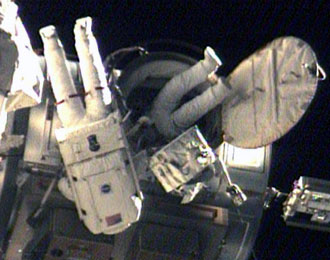The astronauts completed the first spacewalk and installed a new corridor and additional solar collectors

Initially, NASA believed that the launch of the shuttle Atlantis on Friday night was smooth, later it turned out that foam fell from the external fuel tank and caused damage, but this was when the shuttle was at a height where the air was thin enough so that the fallout would not cause problems. In the end, after the comprehensive photographs taken of the shuttle on the first day, on its way to the space station using the robotic arm and right as it approached the space station by the station's astronauts, a lack of a number of protective tiles was discovered.
John Shannon, head of the mission management team, announced in a briefing that took place at 0300 Israel time that NASA is extending the mission by two more days and also adding a fourth spacewalk for the repair.
Early in the morning, astronauts Jim Riley and John (Danny) Olives also successfully completed the mission planned for the first spacewalk on flight STS-117 and successfully activated the new component of the International Space Station. The mission, which lasted six and a quarter hours, ended at 22:17 USA time (05:17 Israel time).
Riley and Olives began their work after their friends connected the new component S3/S4 with the help of the robotic arms. They connected the component to the station's existing electrical and cooling systems, released locks and installed restraints on the component's array of solar collectors and prepared the radiator and bearings for operation. The radiator was already installed during the spacewalk, the solar collector array is still folded and will be deployed today.
The start of the spacewalk and the connection of the new component was delayed due to saturation of the torque gyroscopes used to control the altitude of the station. The flight controllers performed stenotic procedures to return the components to normal operation. Activation of the new component will continue during the second spacewalk of mission STS-117 scheduled for Wednesday evening.
And in the meantime, the US media report that the astronauts yesterday checked a gap that was discovered in the backpack that covers the rocket engine system used for orbit maneuvers. According to Shannon, the fault is not one that will cause a disaster similar to the Ocean of Colombia. "We have already seen ferries with worse damage in this area that returned safely," he said. The gap, measuring 15 x 7.5 centimeters, was discovered during scans of the shuttle's exterior after it reached orbit, a procedure that became standard after the Columbia disaster. The shuttle commander has already confirmed that the mission can be extended if it is necessary to correct this gap. All ferries currently take with them material and tools for such repairs on the route.
